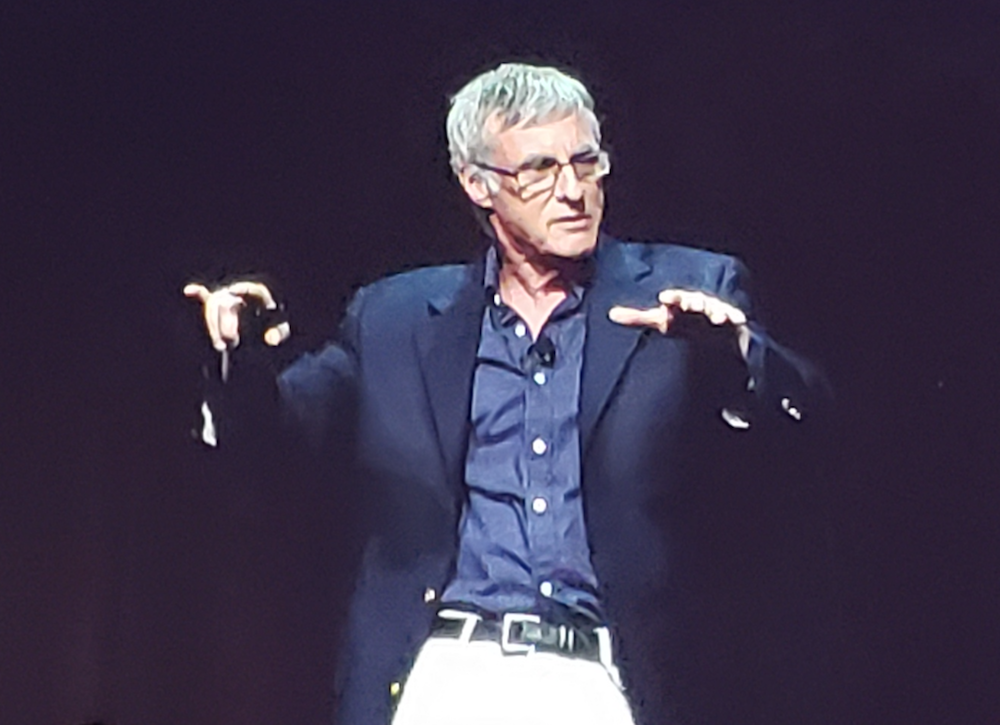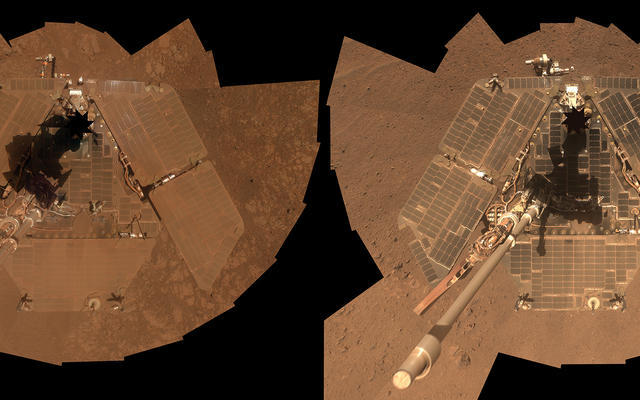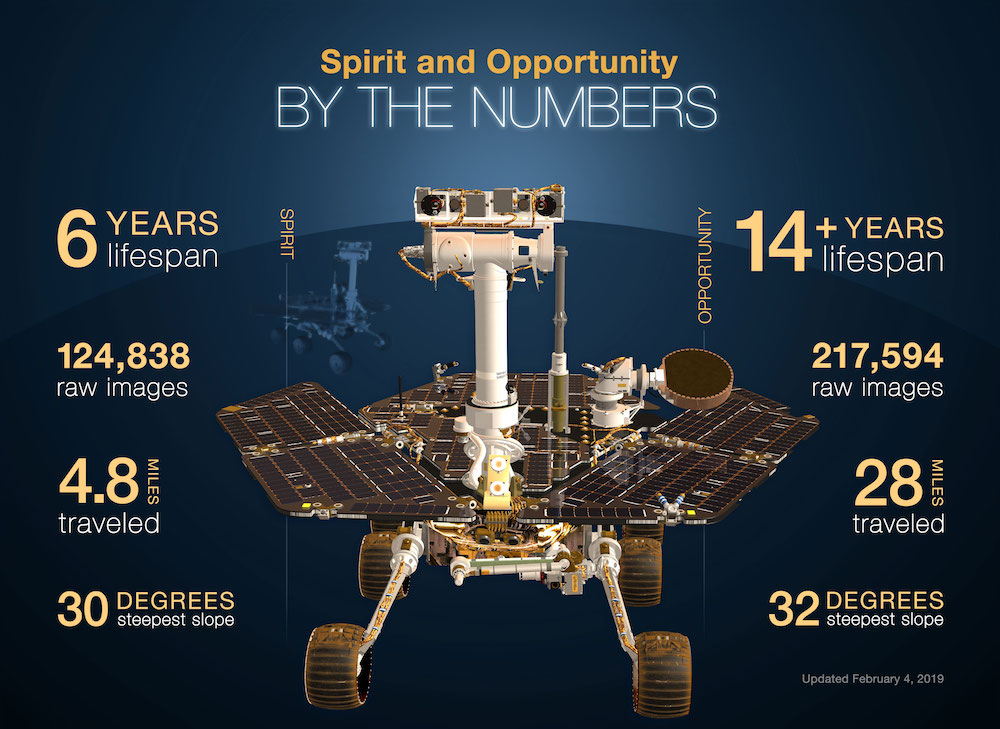Reminding us of the deep and enabling connection between HPC and modern science is an important part of the SC Conference mission. And yes, HPC is a science itself. At SC19, Steve Squyres’ opening keynote recounting the trials and triumphs of the Mars Exploration rovers, Spirit and Opportunity, was just such a reminder.
Leaving aside for a moment the mammoth effort required to get the twin rovers safely to Mars (~225 million km away), the formal mission was to spend 90 days operating in the harsh Martian environment – peering, digging, grinding, analyzing, (surviving) – and send back data from which scientists could better understand all-things-Mars including finding compelling evidence of flowing water on the Earth’s neighbor at some time in the past.

The stakes were high for the Mars Exploration mission (two launches: Spirit (6/10/2003) and Opportunity (7/7/2003) given the embarrassing failure of NASA’s Mars Climate Orbiter resulting from English-to-metric conversion (or lack of) snafu in 1999. Squyres, now a professor at Cornell, was the PI for the new mission and led SC attendees on an engaging journey through the rovers’ long journey from development through conclusion which didn’t happen until June of this 2018 when a giant Martian dust blanketed Opportunity and it ceased transmitting.
There wasn’t a surplus of HPC discussed during the SC keynote, but what an engineering tour de force. Supersonic parachutes (that shredded first during testing). A kind of bubble-wrap for landing. An intricate folded design that protected fragile rover elements beneath layers of protection. Lots of cameras. A handful of sophisticated instruments.
“Once you get down on the surface, the vehicle, there it is. It doesn’t look anything like a like a rover yet. The petals open up and inside still folded up is the rover. Now there are a lot of parts about this whole cockamamie scheme that made me nervous. But this part here with all the gears and motors and the hinges and latches that have to work was terrifying,” said Squyres.
Knitting it altogether, of course, is a computational infrastructure.
“At the heart of each vehicle, lay the mighty RAD 6000 processor (IBM) It was a smoking hot machine in 1987, runs at a screaming 10MIPs. they were the most powerful computers on the planet. Just a different planet,” said Squyres wryly. Here’s a quick description[i]: “The RAD6000 radiation-hardened single board computer, based on the IBM RISC Single Chip CPU, was manufactured by IBM Federal Systems. IBM Federal Systems was sold to Loral, and by way of acquisition, ended up with Lockheed Martin and is currently a part of BAE Systems Electronic Systems. RAD6000 is mainly known as the onboard computer of numerous NASA spacecraft.”
Before chuckling too loudly consider the extraordinary achievements of the twin rovers below.
Squyres was asked why choose the RAD6000 when Moore’s law was speeding along nicely and much higher performance CPUs could be expected by launch-time.
“That’s a really good question. So when you start off all of these projects, NASA says “Here’s the money, Ready Set, Go to the launch pad.” Typically in a well-planned project, one that arises in an orderly fashion, you have about five years between when you get your start and when you have to launch. In our case [we] had 34 months. We had a brutally tight schedule. You have to freeze effectively your design, maybe a year to year and a half [in] because what takes the time is the testing. You have to validate by testing every single part. And our project we’re at 34 months, we froze the technology at the start. Everything every technology that we used was proven technology,” said Squyres.
The keynote is best experienced first-hand and hopefully SC organizers will post a link to a video of the keynote. Space travel and exploration is inherently risky. There’s the ice cold of space itself and danger of radiation. Once at Mars, whose gravity is roughly 1/3 of Earth, the topography is rocky, with canyons, volcanoes, dry lake beds and craters. Temperatures average ~ minus 60 C, but seesaw depending on location and time of day – “A summer day on Mars may get up to 70 degrees F (20 degrees C) near the equator, but at night the temperature can plummet to about minus 100 degrees F (minus 73 C).”[ii] Calling home, of course, is time-lagging chore ~10 mins one way and 20 mins roundtrip.
Both rovers encountered numerous issues ranging from getting stuck in sand to enduring stand storms. Sticking to HPC related challenges, software presented the most troublesome one (maybe some things don’t change no matter what planet you’re on). Squyres reported the team rebuilt the base software several times. The first reboot, five months after launch, was perhaps the most nerve-wracking, he said.
But perhaps the most threatening occurred early on Spirit.
 “At 18 days into Spirit’s mission, we completely lost contact. It just went silent. Now the way that you troubleshoot the problem of spacecraft out in space is you analyze the telemetry. That’s all we had so it was frightening. With time, as days went by, we began to get little fragments of data from the spacecraft, tiny fragments. We realized was the spacecraft was booting up and crashing, booting up and crashing repeatedly every 15 minutes. All through the nighttime. So we’re burning the battery.” This was the kind of behavior that had it gone on for another “three morning sols” [we would lose it],” said Squyres.
“At 18 days into Spirit’s mission, we completely lost contact. It just went silent. Now the way that you troubleshoot the problem of spacecraft out in space is you analyze the telemetry. That’s all we had so it was frightening. With time, as days went by, we began to get little fragments of data from the spacecraft, tiny fragments. We realized was the spacecraft was booting up and crashing, booting up and crashing repeatedly every 15 minutes. All through the nighttime. So we’re burning the battery.” This was the kind of behavior that had it gone on for another “three morning sols” [we would lose it],” said Squyres.
Glenn Reeves, the team software architect, noticed it was all real-time data – “The spacecraft was saying this is what’s happening to me now, this is what’s happening to me now, over and over. No stored data at all. We have 256 megabytes of flash memory on board. None of this [data] was coming out of flash. Glenn’s insight was to realize maybe there was a problem with flash memory file systems.”
It turned out there was an incompatibility between the flight software and the commercial flash memory management software package that didn’t manifest itself until you 18 days into the mission.
“So we had a command called ‘shut-down-dammit’ to force a shut down. We had another command – and both of these were designed only for testing and never used for flight. The other one was called an encrypt-initialize-and-cripple. What that did is lend insight if there’s something wrong with flash; it sends down a shut down command followed by an encrypt-initialize-cripple and brings the thing up in cripple mode. What that does is instead of using flash, it builds a temporary file system in RAM,” said Squyres.
Voila. Spirit came back online. The team worked the problem and built a workaround.
“There was nice little script that somebody wrote up on the white board afterward,” recalled Squyres. It read “The Spirit was willing but the flash was weak.”

There were many tense moments for both of the hardy rovers. Squyres blended entertainment and information in telling the Mars Exploration Rovers story. But it’s good to remember the goal, in addition to satisfying what seems to be our natural spirit for exploration was also to learn more about our captivating neighbor. Bulleted here are five findings excerpted from NASA’s description online:
- Soaked in Salty Waters Long Ago: Landing in a crater, Opportunity scored a “hole in one” by finding the mineral hematite, which typically forms in water. Water is key to life as we know it. Yet, acidic water soaked this area in Mars’ ancient past, making conditions harder for life to thrive.
- Bathing in Neutral Water in a Warmer Climate: At a place called Comanche, Spirit found rocks ten times richer in key chemicals (magnesium and iron carbonates) than any other Martian rocks studied before. These rocks formed when Mars was warm and wet (had a thicker carbon-dioxide atmosphere and near-neutral-pH water). This warmer, watery environment could have supported life much better than the harshly acidic conditions the rover found elsewhere.
- Steamy Times in Ancient Hot Springs: While dragging a wheel, Spirit churned up soil and found 90 percent pure silica at “Home Plate.” On Earth, this kind of silica usually exists in hot springs or hot steam vents, where life as we know it often finds a hot, happy home. Perhaps ancient microbes on Mars did as well.
- Explosive Signs of a Once Heated Habitat: Spirit discovered that an ancient volcano erupted at “Home Plate,” the rover’s final resting place. Together, powerful steam eruptions from heated underground water produced some explosive volcanism. While violent, these extreme conditions can support microbial life on Earth. Once upon a time, maybe they did on Mars…
- Craters and the Story They Tell: Opportunity is a crater explorer. The rover has visited and studied the geology well over 100 impact craters of all sizes in its 14 years on Mars. It has learned about the lives of craters: how they form and erode through time.
[i]https://en.wikipedia.org/wiki/IBM_RAD6000
[ii]https://www.space.com/16907-what-is-the-temperature-of-mars.html



























































